A Meta-Analysis Study on the Use of Biochar to Simultaneously Mitigate Emissions of Reactive Nitrogen Gases (N2O and NO) from Soils
Abstract
1. Introduction
2. Materials and Methods
2.1. Database Compilation
- (I)
- The study must have a paired experiment design, with a treatment group (biochar amendment) and control group (without biochar), both of which had similar field management (including fertilization, irrigation, and tillage regimes).
- (II)
- Soil N2O and NO emissions were monitored simultaneously.
- (III)
- The mean and standard deviation values of the cumulative emissions of the two N oxides, as well as the number of replicates, were documented.
- (A)
- Soil properties:
- (i)
- Soil pH: pH ≤ 6; 6 < pH ≤ 8; and pH > 8.
- (ii)
- Soil organic carbon g kg−1: SOC ≤ 10; 10 < SOC ≤ 20; and SOC > 20.
- (iii)
- Total nitrogen g kg−1: TN ≤ 1; 1 < TN ≤ 2; and TN > 2.
- (iv)
- Clay %: clay ≤ 30 and clay > 30.
- (v)
- Silt %: silt ≤ 30 and silt > 30.
- (vi)
- Sand %: sand ≤ 30 and sand > 30.
- (vii)
- Soil texture: fine (sandy clay, silty clay, and clay); medium (sandy clay loam, clay loam, and silty clay loam); and coarse (sandy, loamy sand, sandy loam, loam, silt loam, and silt) [21].
- (B)
- Biochar properties:
- (i)
- Biochar pH: pH ≤ 7; 7 < pH ≤ 9; and pH > 9.
- (ii)
- Biochar application rate t ha−1: BCAR ≤ 10; 10 < BCAR ≤ 20; and BCAR > 20.
- (iii)
- Total carbon %: TC ≤ 45; 45 < TC ≤ 65; and TC > 65.
- (iv)
- Total nitrogen g kg−1: TN ≤ 6; 6 < TN ≤ 12; and TN > 12.
- (v)
- Pyrolysis temperature °C: PT ≤ 400; 400 < PT ≤ 500; and PT > 500.
- (vi)
- Feedstock types: herbaceous waste; wood; and manure.
- (C)
- Field management conditions:
- (i)
- Experimental types: field; greenhouse; pot; and incubation.
- (ii)
- Fertilizer types: urea; ammonium; compound; and organic.
- (iii)
- N Application rate kg N ha−1: NAR ≤ 200; 200 < NAR ≤ 400; and NAR > 400.
2.2. Meta-Analysis
2.3. Analysis of Influencing Factors Affecting Biochar Amendment Efficacy
3. Results
3.1. Effects of Biochar Application on Soil-Nitrogen Oxide Emissions
3.2. Effects of Soil Properties on Nitrogen Oxides Mitigation Potential of Biochar Amendment
3.3. Effects of Biochar Characteristics on Nitrogen Oxide Mitigation Potential of Biochar Amendment
3.4. Effects of Field Management Conditions on the Nitrogen Oxide Mitigation Potential of Biochar Amendment
3.5. Influencing Factors Affecting Soil-Nitrogen Oxide Emissions after Biochar Amendment
4. Discussion
4.1. Effects of Soil Properties on N2O and NO Emissions after Biochar Amendment
4.2. Effects of Biochar Characteristics on N2O and NO Emissions
4.3. Effects of Field Management Conditions on N2O and NO Emission after Biochar Amendment
5. Conclusions
Supplementary Materials
Author Contributions
Funding
Institutional Review Board Statement
Informed Consent Statement
Data Availability Statement
Conflicts of Interest
References
- Erisman, J.W.; Bleeker, A.; Galloway, J.; Sutton, M.S. Reduced nitrogen in ecology and the environment. Environ. Pollut. 2007, 150, 140–149. [Google Scholar] [CrossRef] [PubMed]
- Xu, C.; Zhang, K.; Zhu, W.; Xiao, J.; Zhu, C.; Zhang, N.; Yu, F.; Li, S.; Zhu, C.; Tu, Q.; et al. Large losses of ammonium-nitrogen from a rice ecosystem under elevated CO2. Ecology 2020, 6, eabb7433. [Google Scholar] [CrossRef]
- Ma, R.; Zou, J.; Han, Z.; Yu, K.; Wu, S.; Li, Z.; Liu, S.; Niu, S.; Horwath, W.R.; Zhu-Barker, X. Global soil-derived ammonia emissions from agricultural nitrogen fertilizer application: A refinement based on regional and crop-specific emission factors. Glob. Change Biol. 2020, 27, 855–867. [Google Scholar] [CrossRef]
- Xia, L.; Lam, S.K.; Yan, X.; Chen, D. How Does Recycling of Livestock Manure in Agroecosystems Affect Crop Productivity, Reactive Nitrogen Losses, and Soil Carbon Balance? Environmental. Sci. Technol. 2017, 51, 7450–7457. [Google Scholar] [CrossRef] [PubMed]
- Feng, Y.; Feng, Y.; Liu, Q.; Chen, S.; Hou, P.; Poinern, G.; Jiang, Z.; Fawcett, D.; Xue, L.; Lam, S.S.; et al. How does biochar aging affect NH3 volatilization and GHGs emissions from agricultural soils? Environ. Pollut. 2022, 294, 118598. [Google Scholar] [CrossRef] [PubMed]
- Prather, M.J.; Hsu, J.; DeLuca, N.M.; Jackman, C.H.; Oman, L.D.; Douglass, A.R.; Fleming, E.L.; Strahan, S.E.; Steenrod, S.D.; Søvde, O.A.; et al. Measuring and modeling the lifetime of nitrous oxide including its variability. Geophys. Res. Atmos. 2015, 120, 5693–5705. [Google Scholar] [CrossRef] [PubMed]
- Shakoor, A.; Shahzad, S.M.; Chatterjee, N.; Arifd, M.S.; Farooq, T.H.; Altaff, M.M.; Tufail, M.A.; Dar, A.A.; Mehmood, T. Nitrous oxide emission from agricultural soils: Application of animal manure or biochar? A global meta-analysis. Environ. Manag. 2021, 285, 112170. [Google Scholar] [CrossRef]
- Tian, H.; Xu, R.; Canadell, J.G.; Thompson, R.L.; Winiwarter, W.; Suntharalingam, P.; Davidson, E.A.; Ciais, P.; Jackson, R.B.; Janssens-Maenhout, G.; et al. A comprehensive quantification of global nitrous oxide sources and sinks. Nature 2020, 586, 248–256. [Google Scholar] [CrossRef]
- Wang, Y.; Yao, Z.; Zheng, X.; Subramaniam, L.; Butterbach-Bahl, K. A synthesis of nitric oxide emissions across global fertilized croplands from crop-specific emission factors. Glob. Change Biol. 2022, 28, 4395–4408. [Google Scholar] [CrossRef]
- Akiyama, H.; Yan, X.; Yagi, K. Evaluation of effectiveness of enhanced-efficiency fertilizers as mitigation options for N2O and NO emissions from agricultural soils: Meta-analysis. Glob. Change Biol. 2010, 16, 1837–1846. [Google Scholar] [CrossRef]
- Ludwig, J.; Meixner, F.X.; Vogel, B.; Förstner, J. Soil-air exchange of nitric oxide: An overview of processes, environmental factors, and modeling studies. Biogeochemistry 2001, 52, 225–257. [Google Scholar] [CrossRef]
- Firestone, M.K.; Davidson, E.A. Microbiological Basis of NO and N2O Production and Consumption in Soil. Exch. Trace Gases Between Terr. Ecosyst. Atmos 1989, 47, 7–21. [Google Scholar]
- Nguyen, T.T.N.; Xu, C.-Y.; Tahmasbian, I.; Che, R.; Xu, Z.; Zhou, X.; Wallace, H.M.; Bai, S.H. Effects of biochar on soil available inorganic nitrogen: A review and meta-analysis. Geoderma 2017, 288, 79–96. [Google Scholar] [CrossRef]
- Obia, A.; Cornelissen, G.; Mulder, J.; Dörsch, P. Effect of Soil pH Increase by Biochar on NO, N2O and N2 Production during Denitrification in Acid Soils. PLoS ONE 2015, 10, e0138781. [Google Scholar] [CrossRef]
- Karim, A.A.; Kumar, M.; Singh, E.; Kumar, A.; Kumar, S.; Ray, A.; Dhal, N.K. Enrichment of primary macronutrients in biochar for sustainable agriculture: A review. Environ. Sci. Technol. 2021, 52, 1449–1490. [Google Scholar] [CrossRef]
- Smith, P. Soil carbon sequestration and biochar as negative emission technologies. Glob. Change Biol. 2016, 22, 1315–1324. [Google Scholar] [CrossRef] [PubMed]
- Ji, C.; Li, S.; Geng, Y.; Yuan, Y.; Zhi, J.; Yu, K.; Han, Z.; Wu, S.; Liu, S.; Zou, J. Decreased N2O and NO emissions associated with stimulated denitrification following biochar amendment in subtropical tea plantations. Geoderma 2020, 365, 114223. [Google Scholar] [CrossRef]
- Liu, Q.; Zhang, Y.; Liu, B.; Amonette James, E.; Lin, Z.; Liu, G.; Ambus, P.; Xie, Z. How does biochar influence soil N cycle? A meta-analysis. Plant Soil 2018, 426, 211–225. [Google Scholar] [CrossRef]
- Saeed, A.A.H.; Harun, N.Y.; Sufian, S.; Bilad, M.R.; Zakaria, Z.Y.; Jagaba, A.H.; Ghaleb, A.A.S.; Mohammed, H.G. Pristine and Magnetic Kenaf Fiber Biochar for Cd2+ Adsorption from Aqueous Solution. Environ. Res. Public Health 2021, 18, 7949. [Google Scholar] [CrossRef]
- Al-Mahbashi, N.M.Y.; Kutty, S.R.M.; Bilad, M.R.; Huda, N.; Kobun, R.; Noor, A.; Jagaba, A.H.; Al-Nini, A.; Ghaleb, A.A.S.; Al-dhawi, B.N.S. Bench-Scale Fixed-Bed Column Study for the Removal of Dye-Contaminated Effluent Using Sewage-Sludge-Based Biochar. Sustainability 2022, 14, 6484. [Google Scholar] [CrossRef]
- Sha, Z.; Li, Q.; Lv, T.; Misselbrook, T.; Liu, X. Response ofammonia volatilization to biochar addition: A meta-analysis. Sci. Total Environ. 2019, 655, 1387–1396. [Google Scholar] [CrossRef] [PubMed]
- Hedges, L.V.; Gurevitch, J.; Curtis, P.S. The meta-analysis of response ratios in experimental ecology. Ecology 1999, 80, 1150–1156. [Google Scholar] [CrossRef]
- Adams, D.C.; Gurevitch, J.; Rosenberg, M.S. Resampling tests for meta-analysis of ecological data. Ecology 1997, 78, 1277–1283. [Google Scholar] [CrossRef]
- Borenstein, M.; Hedges, L.V.; Higgins, J.T.; Rothstein, H. Introduction to Meta-Analysis; John Wiley & Sons: Hoboken, NJ, USA, 2009. [Google Scholar]
- Peng, S.; Kinlock, N.L.; Gurevitch, J.; Peng, S. Correlation of native and exotic species richness: A global meta-analysis finds no invasion paradox across scales. Ecology 2019, 100, 02552. [Google Scholar] [CrossRef]
- Sterne, J.A.C.; Egger, M. Regression Methods to Detect Publication and Other Bias in Meta-Analysis; John Wiley & Sons: Hoboken, NJ, USA, 2006. [Google Scholar] [CrossRef]
- Elith, J.; Leathwick, J.R.; Hastie, T. A working guide to boosted regression trees. Anim. Ecol. 2008, 77, 802–813. [Google Scholar] [CrossRef]
- Carslaw, D.C.; Taylor, P.J. Analysis of air pollution data at a mixed source location using boosted regression trees. Atmos. Environ. 2009, 43, 3563–3570. [Google Scholar] [CrossRef]
- Leathwick, J.R.; Elith, J.; Hastie, T.; Taylor, P. Variation in demersal fish species richness in the oceans surrounding New Zealand: An analysis using boosted regression trees. Mar. Ecol.-Prog. Ser. 2006, 321, 267–281. [Google Scholar] [CrossRef]
- Zhang, W.; Yuan, S.; Hu, N.; Lou, Y.; Wang, S. Predicting soil fauna effect on plant litter decomposition by using boosted regression trees. Soil Biol. Biochem. 2015, 82, 81–86. [Google Scholar] [CrossRef]
- Elith, J.; Leathwick, J. Boosted Regression Trees for Ecological Modeling. R Documentation. Available online: https://cran.r-project.org/web/packages/dismo/vignettes/brt.pdf (accessed on 12 June 2011).
- Jouffray, J.-B.; Wedding, L.M.; Norstro¨m, A.V.; Donovan, M.K.; Williams, G.J.; Crowder, L.B.; Erickson, A.L.; Friedlander, A.M.; Graham, N.A.J.; Gove, J.M.; et al. Parsing human and biophysical drivers of coral reef regimes. Ecology 2019, 286, 20182544. [Google Scholar] [CrossRef]
- Zhang, Y.; Chen, H.Y.H.; Reich, P.B. Forest productivity increases with evenness, species richness and trait variation: A global meta-analysis. Ecology 2012, 100, 742–749. [Google Scholar] [CrossRef]
- Nguyen, D.B.; Rose, M.T.; Rose, T.J.; Morris, S.G.; Zwieten, L.v. Impact of glyphosate on soil microbial biomass and respiration: A meta-analysis. Soil Biol. Biochem. 2016, 92, 50–57. [Google Scholar] [CrossRef]
- Azeem, M.; Hayatb, R.; Hussainb, Q.; Ahmedc, M.; Pand, G.; Tahira, M.I.; Imrane, M.; Irfanb, M.; Mehmood-ul, H. Biochar improves soil quality and N2-fixation and reduces net ecosystem CO2 exchange in a dryland legume-cereal cropping system. Soil Tillage Res. 2019, 186, 172–182. [Google Scholar] [CrossRef]
- Cayuela, M.L.; Zwietenb, L.v.; Singhb, B.P.; Jefferyc, S.; Roiga, A.; Sánchez-Monederoa, M.A. Biochar’s role in mitigating soil nitrous oxide emissions: A review and meta-analysis. Agriculture Ecosyst. Environ. 2014, 191, 5–16. [Google Scholar] [CrossRef]
- Gaillard, R.; Duval, B.D.; Osterholz, W.R.; Kucharik, C.J. Simulated Effects of Soil Texture on Nitrous Oxide Emission Factors from Corn and Soybean Agroecosystems in Wisconsin. Environ. Qual. 2016, 45, 1540–1548. [Google Scholar] [CrossRef] [PubMed]
- Gai, X.; Wang, H.; Liu, J.; Zhai, L.; Liu, S.; Ren, T.; Liu, H. Effects of Feedstock and Pyrolysis Temperature on Biochar Adsorption of Ammonium and Nitrate. PLoS ONE 2014, 9, e113888. [Google Scholar] [CrossRef] [PubMed]
- Yu, Y.; Zhao, C.; Zheng, N.; Jia, H.; Yao, H. Interactive effects of soil texture and salinity on nitrous oxide emissions following crop residue amendment. Geoderma 2019, 337, 1146–1154. [Google Scholar] [CrossRef]
- Fan, C.; Chen, H.; Li, B.; Xiong, Z. Biochar reduces yield-scaled emissions of reactive nitrogen gases from vegetable soils across China. Biogeosciences 2017, 14, 2851–2863. [Google Scholar] [CrossRef]
- Xu, H.-J.; Wang, X.-H.; Li, H.; Yao, H.-Y.; Su, J.-Q.; Zhu, Y.-G. Biochar Impacts Soil Microbial Community Composition and Nitrogen Cycling in an Acidic Soil Planted with Rape. Environmental. Sci. Technol. 2014, 48, 9391–9399. [Google Scholar] [CrossRef]
- Xiao, Z.; Rasmann, S.; Yue, L.; Lian, F.; Zou, H.; Wang, Z. The effect of biochar amendment on N-cycling genes in soils: A metaanalysis. Sci. Total Environ. 2019, 696, 133984. [Google Scholar] [CrossRef]
- Zhang, Y.; Zhang, Z.; Chen, Y. Biochar Mitigates N2O Emission of Microbial Denitrification through Modulating Carbon Metabolism and Allocation of Reducing Power. Environ. Sci. Technol. 2021, 55, 8068–8078. [Google Scholar] [CrossRef]
- Zhu, K.; Ye, X.; Ran, H.; Zhang, P.; Wang, G. Contrasting effects of straw and biochar on microscale heterogeneity of soil O2 and pH: Implication for N2O emissions. Soil Biol. Biochem. 2022, 166, 108564. [Google Scholar] [CrossRef]
- Rittl, T.F.; Butterbach-Bahlb, K.; Basilea, C.M.; Pereiraa, L.A.; Almsa, V.; Dannenmannb, M.; Coutoc, E.G.; Cerria, C.E.P. Greenhouse gas emissions from soil amended with agricultural residue biochars: Effects of feedstock type, production temperature and soil moisture. Biomass Bioenergy 2018, 117, 1–9. [Google Scholar] [CrossRef]
- Liao, X.; Niu, Y.; Liu, D.; Chen, Z.; He, T.; Luo, J.; Lindsey, S.; Ding, W. Four-year continuous residual effects of biochar application to a sandy loam soil on crop yield and N2O and NO emissions under maize-wheat rotation. Agric. Ecosyst. Environ. 2020, 302, 107109. [Google Scholar] [CrossRef]
- Sha, Z.; Ma, X.; Loick, N.; Lv, T.; Cardenas, L.M.; Ma, Y.; Liu, X.; Misselbrook, T. Nitrogen stabilizers mitigate reactive N and greenhouse gas emissions from an arable soil in North China Plain: Field and laboratory investigation. J. Clean. Prod. 2020, 258, 121025. [Google Scholar] [CrossRef]
- Davidson, E.A.; Keller, M.; Erickson, H.E.; Verchot, L.V.; Veldkamp, E. Testing a Conceptual Model of Soil Emissions of Nitrous and Nitric Oxides. BioScience 2000, 50, 667–680. [Google Scholar] [CrossRef]
- Edeh, I.G.; Masek, O.; Buss, W. A meta-analysis on biochar’s effects on soil water properties—New insights and future research challenges. Sci. Total Env. 2020, 714, 136857. [Google Scholar] [CrossRef]
- Razzaghi, F.; Obour, P.B.; Arthur, E. Does biochar improve soil water retention? A systematic review and meta-analysis. Geoderma 2020, 361, 114055. [Google Scholar] [CrossRef]
- Wang, J.; Zhang, M.; Xiong, Z.; Liu, P.; Pan, G. Effects of biochar addition on N2O and CO2 emissions from two paddy soils. Biol. Fertil. Soils 2011, 47, 887–896. [Google Scholar] [CrossRef]
- Zhang, Y.; Wang, H.; Maucierid, C.; Liu, S.; Zou, J. Annual nitric and nitrous oxide emissions response to biochar amendment from an intensive greenhouse vegetable system in southeast China. Sci. Hortic. 2019, 246, 879–886. [Google Scholar] [CrossRef]
- Chen, G.; Zhang, Z.; Zhang, Z.; Zhang, R. Redox-active reactions in denitrification provided by biochars pyrolyzed at different temperatures. Sci. Total Environ. 2017, 615, 1547–1556. [Google Scholar] [CrossRef]
- Yuan, H.; Zhang, Z.; Li, M.; Clough, T.; Wrage-Mönnigc, N.; Qin, S.; Ge, T.; Liao, H.; Zhou, S. Biochar’s role as an electron shuttle for mediating soil N2O emissions. Soil Biol. Biochem. 2019, 133, 94–96. [Google Scholar] [CrossRef]
- Klüpfel, L.; Keiluweit, M.; Kleber, M.; Sander, M. Redox Properties of Plant Biomass-Derived Black Carbon (Biochar). Environ. Sci. Technol. 2014, 48, 5601–5611. [Google Scholar] [CrossRef] [PubMed]
- Weldon, S.; Rassea, D.P.; Budaia, A.; Tomicb, O.; Dörschc, P. The effect of a biochar temperature series on denitrification: Which biochar properties matter? Soil Biol. Biochem. 2019, 135, 173–183. [Google Scholar] [CrossRef]
- Wei, J.; Sun, W.; Pan, W.; Yu, X.; Sun, G.; Jiang, H. Comparing the effects of different oxygen-containing functional groups on sulfonamides adsorption by carbon nanotubes: Experiments and theoretical calculation. Chem. Eng. J. 2017, 312, 167–179. [Google Scholar] [CrossRef]
- Chintala, R.; Mollinedo, J.; Schumacher, T.E.; Malo, D.D.; Julson, J.L. Effect of biochar on chemical properties of acidic soil. Arch. Agron. Soil Sci. 2014, 60, 393–404. [Google Scholar] [CrossRef]
- Zhao, L.; Cao, X.; Mašek, O.; Zimmerman, A. Heterogeneity of biochar properties as a function of feedstock sources and production temperatures. Hazard. Mater. 2013, 256–257, 1–9. [Google Scholar] [CrossRef]
- Quin, P.; Joseph, S.; Husson, O.; Donne, S.; Mitchell, D.; Munroe, P.; Phelan, D.; Cowie, A.; Zwieten, L.V. Lowering N2O emissions from soils using eucalypt biochar: The importance of redox reactions. Nature 2015, 5, 16773. [Google Scholar] [CrossRef]
- Ma, R.; Yu, K.; Xiao, S.; Liu, S.; Ciais, P.; Zou, J. Data- driven estimates of fertilizer- induced soil NH3, NO and N2O emissions from croplands in China and their climate change impacts. Glob. Change Biol. 2022, 28, 1008–1022. [Google Scholar] [CrossRef]
- Xiang, J.; Liu, D.; Ding, W.; Yuan, J.; Lin, Y. Effects of biochar on nitrous oxide and nitric oxide emissions from paddy field during the wheat growth season. Clean. Prod. 2015, 104, 52–58. [Google Scholar] [CrossRef]
- Dawar, K.; Fahad, S.; Jahangir, M.M.R.; Munir, I.; Alam, S.S.; Khan, S.A.; Mian, I.A.; Datta, R.; Saud, S.; Banout, J.; et al. Biochar and urease inhibitor mitigate NH3 and N2O emissions and improve wheat yield in a urea fertilized alkaline soil. Nature 2021, 11, 17413. [Google Scholar] [CrossRef]
- Chen, D.; Suter, H.C.; Islam, A.; Edis, R. Influence of nitrification inhibitors on nitrification and nitrous oxide (N2O) emission from a clay loam soil fertilized with urea. Soil Biol. Biochem. 2010, 42, 660–664. [Google Scholar] [CrossRef]
- Lu, L.; Han, W.; Zhang, J.; Wu, Y.; Wang, B.; Lin, X.; Zhu, J.; Cai, Z.; Jia, Z. Nitrification of archaeal ammonia oxidizers in acid soils is supported by hydrolysis of urea. Int. Soc. Microb. Ecol. 2012, 6, 1978–1984. [Google Scholar] [CrossRef] [PubMed]
- Feng, Z.; Zhu, L. Impact of biochar on soil N2O emissions under different biochar-carbon/ fertilizer-nitrogen ratios at a constant moisture condition on a silt loam soi. Sci. Total Environ. 2017, 584–585, 776–782. [Google Scholar] [CrossRef] [PubMed]
- Nelissen, V.; Saha, B.K.; Ruysschaert, G.; Boeckx, P. Effect of different biochar and fertilizer types on N2O and NO emissions. Soil Biol. Biochem. 2014, 70, 244–255. [Google Scholar] [CrossRef]
- Mulvaney, R.L.; Khan, S.A.; Mulvaney, C.S. Nitrogen fertilizers promote denitrification. Biol. Fertil. Soils 1997, 24, 211–220. [Google Scholar] [CrossRef]
- Burns, L.C.; Stevens, R.J.; Laughlin, R.J. Production of nitrite in soil by simultaneous nitrification and denitrification. Soil Biol. Biochem. 1996, 28, 609–616. [Google Scholar] [CrossRef]
- Heil, J.; Vereeckena, H.; Brüggemanna, N. A review of chemical reactions of nitrification intermediates and their role in nitrogen cycling and nitrogen trace gas formation in soil. Eur. J. Soil Sci. 2016, 67, 23–39. [Google Scholar] [CrossRef]
- Douglas, J.T.; Arvist, M.G.J.; Arvist, K.R.; Gossf, M.J. Structure of a silty soil in relation to management. J. Soil Sci. 1986, 37, 137–151. [Google Scholar] [CrossRef]
- Cui, J. Nitrification characteristics and emission rules of N2O and NO in typical tea plantation soils in China. Nanjing Normal University 2017. (In Chinese) [Google Scholar]
- Fan, C.; Duan, P.; Zhang, X.; Shen, H.; Chen, M.; Xiong, Z. Mechanisms underlying the mitigation of both N2O and NO emissions with field-aged biochar in an Anthrosol. Geoderma 2020, 364, 114178. [Google Scholar] [CrossRef]
- Han, Z.; Wang, J.; Xu, P.; Li, Z.; Liu, S.; Zou, J. Differential responses of soil nitrogen- oxide emissions to organic substitution for synthetic fertilizer and biochar amendment in a subtropical tea plantation. Glob. Change Biol. -Bioenergy 2021, 13, 1260–1274. [Google Scholar] [CrossRef]
- He, T.; Liu, D.; Yuan, J.; Luo, J.; Lindsey, S.; Bolan, N.; Ding, W. Effects of application of inhibitors and biochar to fertilizer on gaseous nitrogen emissions from an intensively managed wheat field. Sci. Total Environ. 2018, 628–629, 121–130. [Google Scholar] [CrossRef]
- He, T.; Yuan, J.; Luo, J.; Wang, W.; Fan, J.; Liu, D.; Ding, W. Organic fertilizers have divergent effects on soil N2O emissions. Biol. Fertil. Soils 2019, 55, 685–699. [Google Scholar] [CrossRef]
- Niu, Y.; Luo, J.; Liu, D.; Müller, C.; Zaman, M.; Lindsey, S.; Ding, W. Effect of biochar and nitrapyrin on nitrous oxide and nitric oxide emissions from a sandy loam soil cropped to maize. Biol. Fertil. Soils 2018, 54, 645–658. [Google Scholar] [CrossRef]
- Sun, L.; Li, J.; Fan, C.; Deng, J.; Zhou, W.; Aihemaiti, A.; Yalkun, U.J. The effects of biochar and nitrification inhibitors on reactive nitrogen gas (N2O, NO and NH3) emissions in intensive vegetable fields in southeastern China. Arch. Agron. Soil Sci. 2020, 67, 836–848. [Google Scholar] [CrossRef]
- Wu, Z.; Zhang, Q.; Zhang, X.; Duan, P.; Yan, X.; Xiong, Z. Biochar-enriched soil mitigated N2O and NO emissions similarly as fresh biochar for wheat production. Sci. Total Environ. 2020, 701, 134943. [Google Scholar] [CrossRef]
- Zhang, X.; Duan, P.; Wu, Z.; Xiong, Z. Aged biochar stimulated ammonia-oxidizing archaea and bacteria-derived N2O and NO production in an acidic vegetable soil. Sci. Total Environ. 2019, 687, 433–440. [Google Scholar] [CrossRef]
- Zhi, J. N2O and NO emission from tea plantation soil under biochar application. Nanjing Agricultural University 2017. (In Chinese) [Google Scholar]
- Zhu, Y. Effects of combined application of biochar and nitrification inhibitor on soil emission reduction in vegetable fields and its microbial mechanism. Guizhou Minzu University 2021. (In Chinese) [Google Scholar]
- Feng, L. Effects of nitrogen fertilizer and biochar application on NO and N2O emission and yield in vegetable fields. Nanjing Agricultural University 2019. (In Chinese) [Google Scholar]
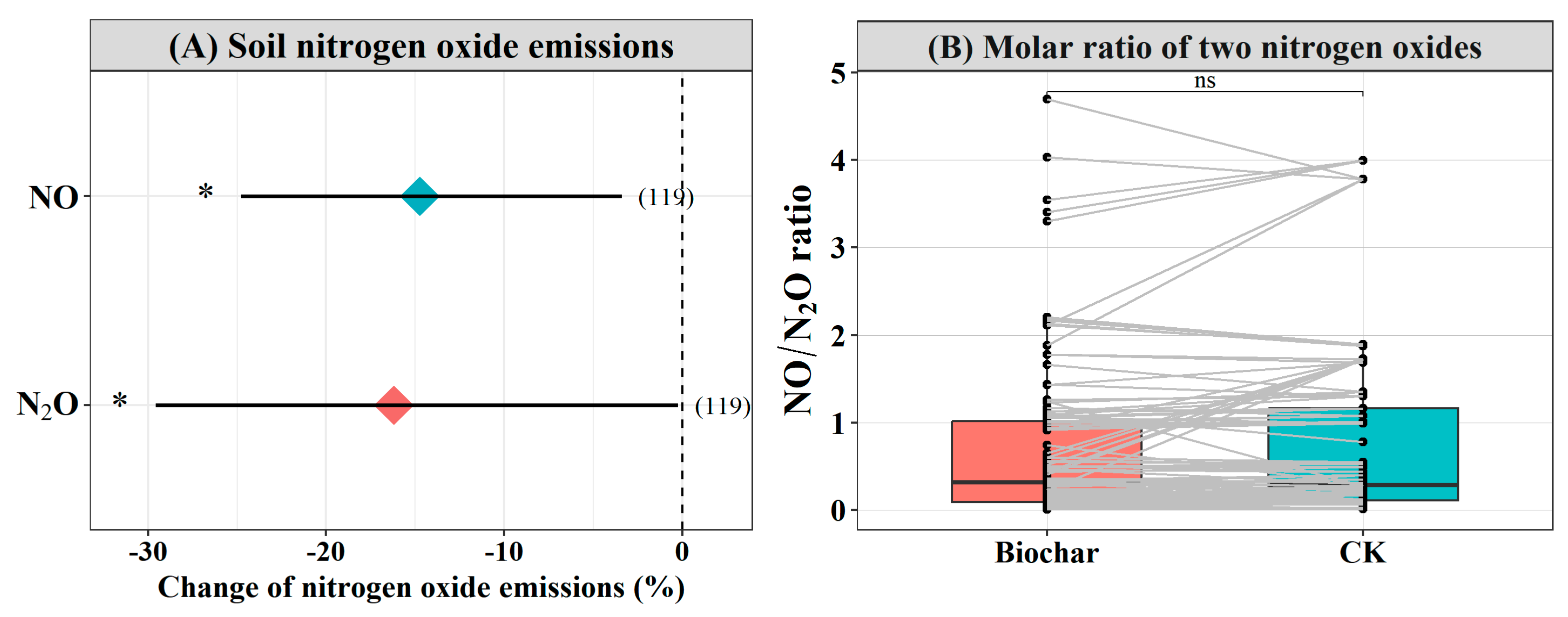
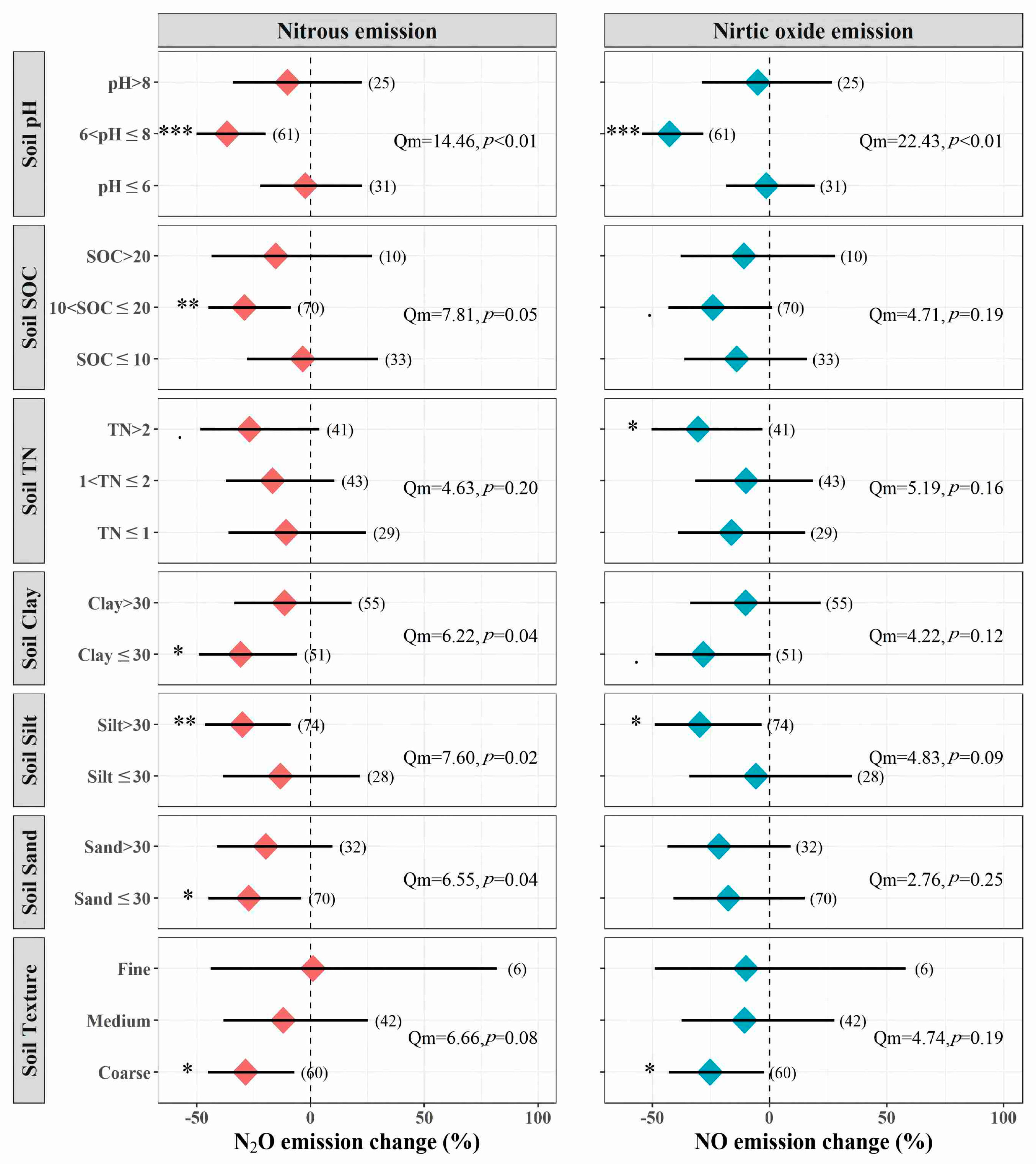
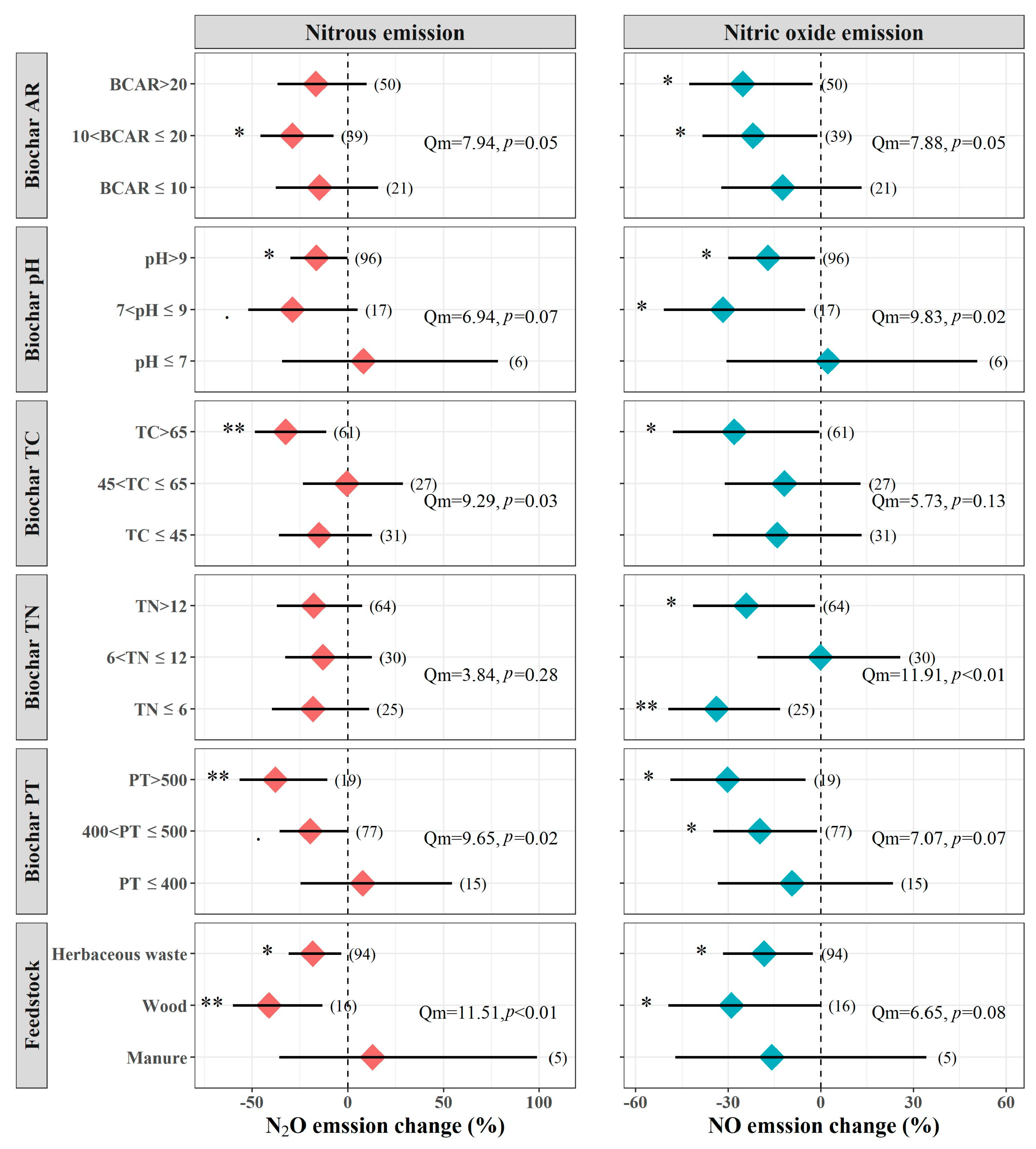
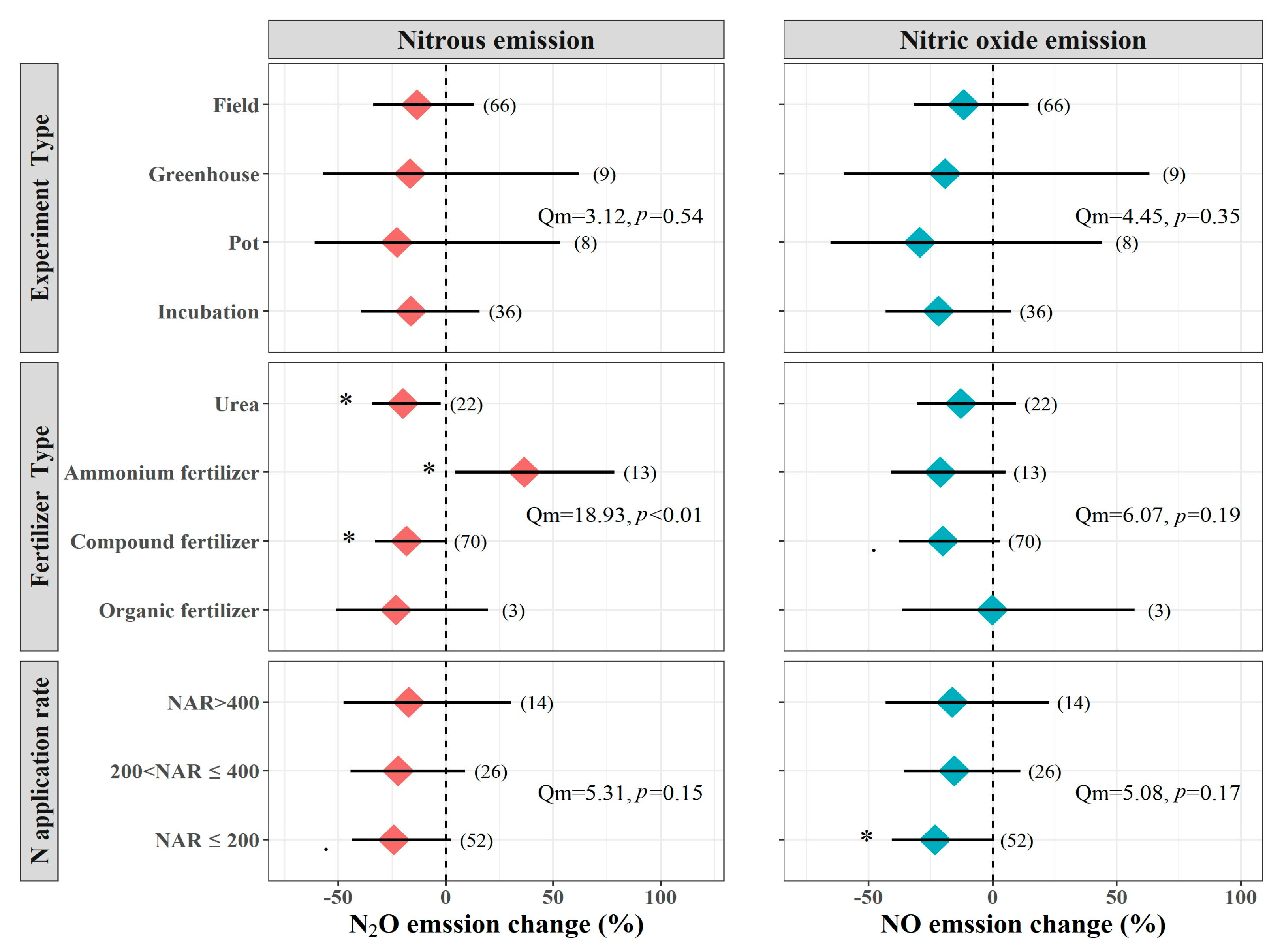

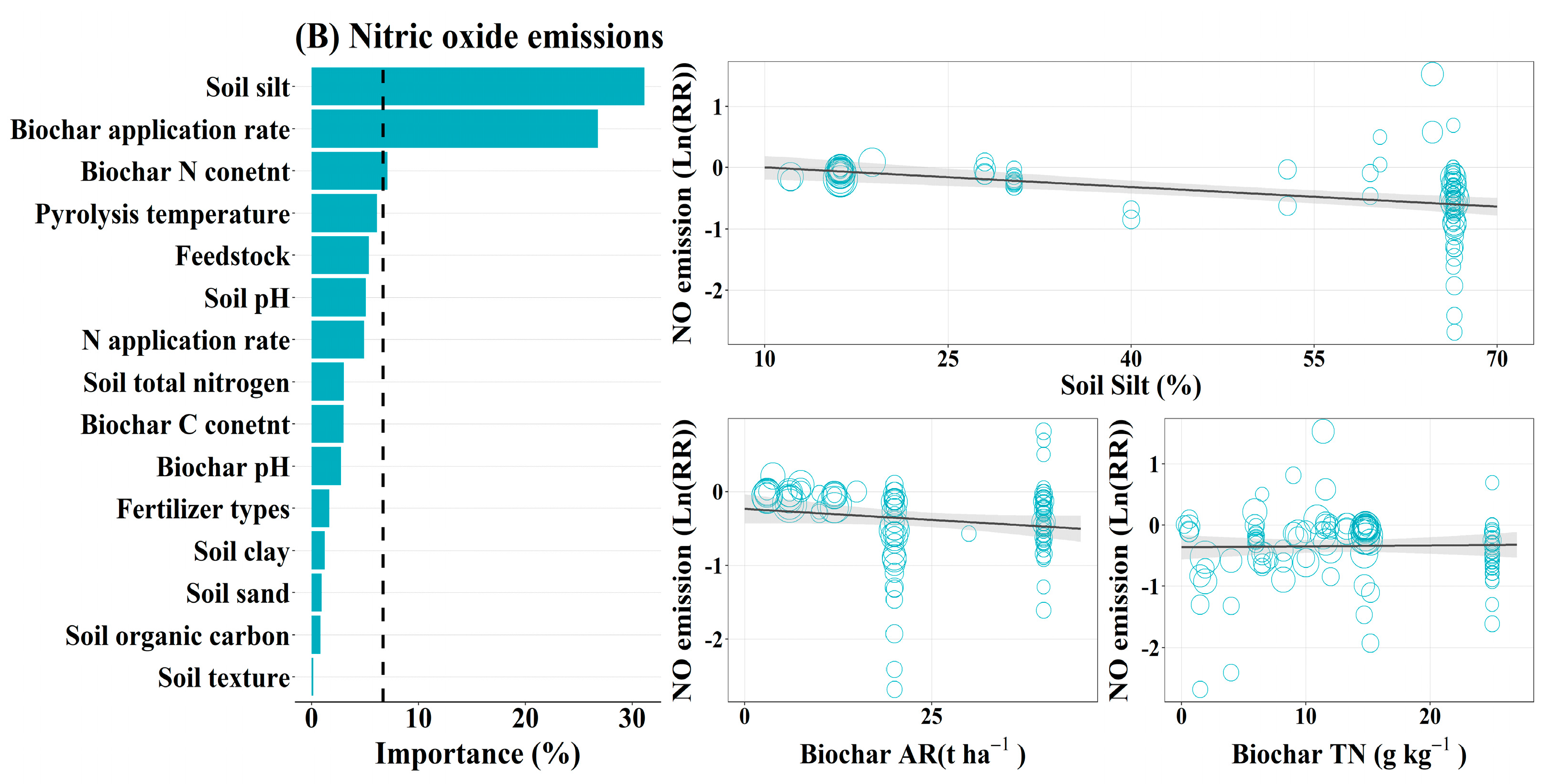
Disclaimer/Publisher’s Note: The statements, opinions and data contained in all publications are solely those of the individual author(s) and contributor(s) and not of MDPI and/or the editor(s). MDPI and/or the editor(s) disclaim responsibility for any injury to people or property resulting from any ideas, methods, instructions or products referred to in the content. |
© 2023 by the authors. Licensee MDPI, Basel, Switzerland. This article is an open access article distributed under the terms and conditions of the Creative Commons Attribution (CC BY) license (https://creativecommons.org/licenses/by/4.0/).
Share and Cite
Zhang, X.; Lv, J.; Zhang, Y.; Li, S.; Chen, X.; Sha, Z. A Meta-Analysis Study on the Use of Biochar to Simultaneously Mitigate Emissions of Reactive Nitrogen Gases (N2O and NO) from Soils. Sustainability 2023, 15, 2384. https://doi.org/10.3390/su15032384
Zhang X, Lv J, Zhang Y, Li S, Chen X, Sha Z. A Meta-Analysis Study on the Use of Biochar to Simultaneously Mitigate Emissions of Reactive Nitrogen Gases (N2O and NO) from Soils. Sustainability. 2023; 15(3):2384. https://doi.org/10.3390/su15032384
Chicago/Turabian StyleZhang, Xiayan, Jiyang Lv, Yuyang Zhang, Shouguo Li, Xian Chen, and Zhipeng Sha. 2023. "A Meta-Analysis Study on the Use of Biochar to Simultaneously Mitigate Emissions of Reactive Nitrogen Gases (N2O and NO) from Soils" Sustainability 15, no. 3: 2384. https://doi.org/10.3390/su15032384
APA StyleZhang, X., Lv, J., Zhang, Y., Li, S., Chen, X., & Sha, Z. (2023). A Meta-Analysis Study on the Use of Biochar to Simultaneously Mitigate Emissions of Reactive Nitrogen Gases (N2O and NO) from Soils. Sustainability, 15(3), 2384. https://doi.org/10.3390/su15032384




